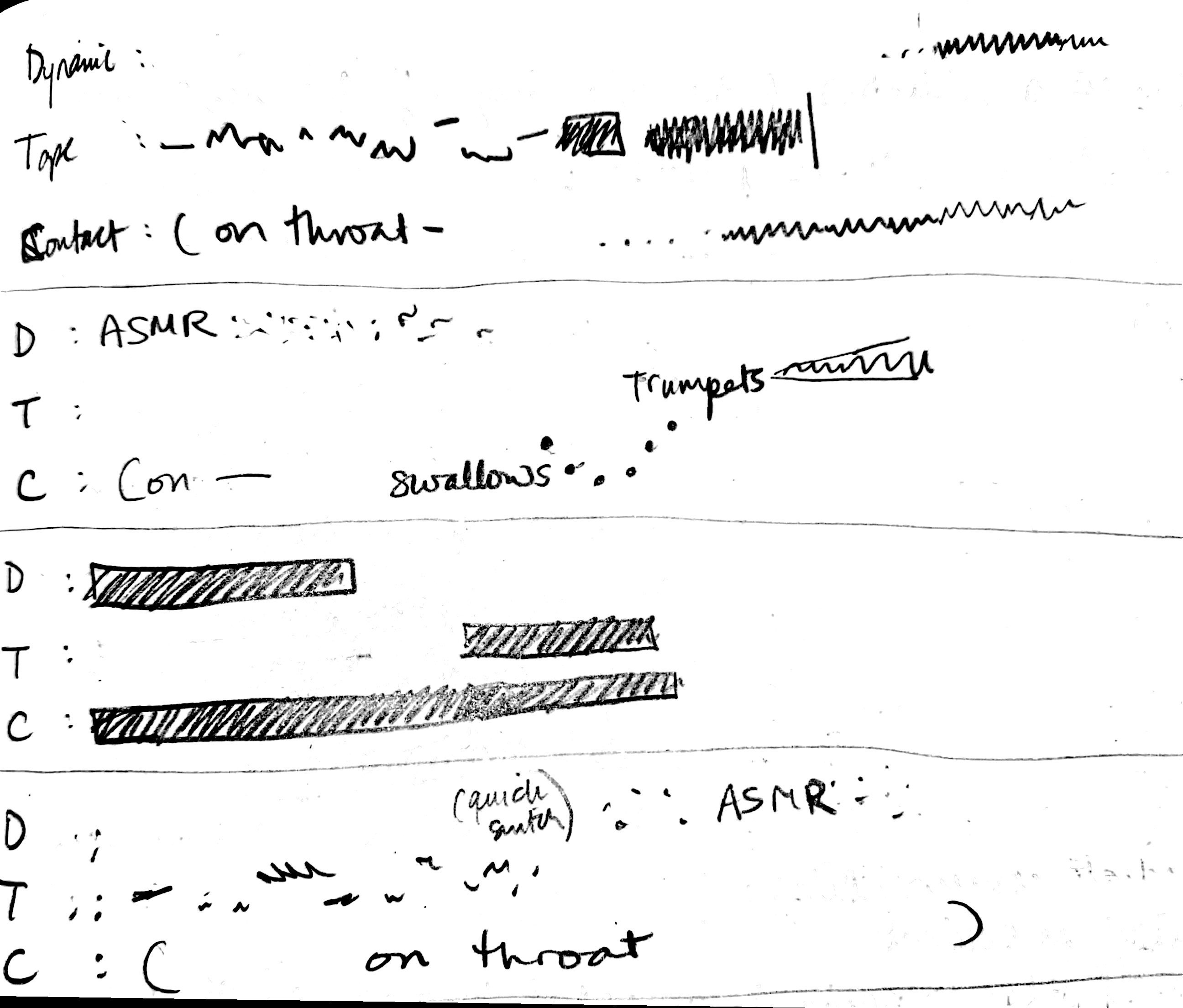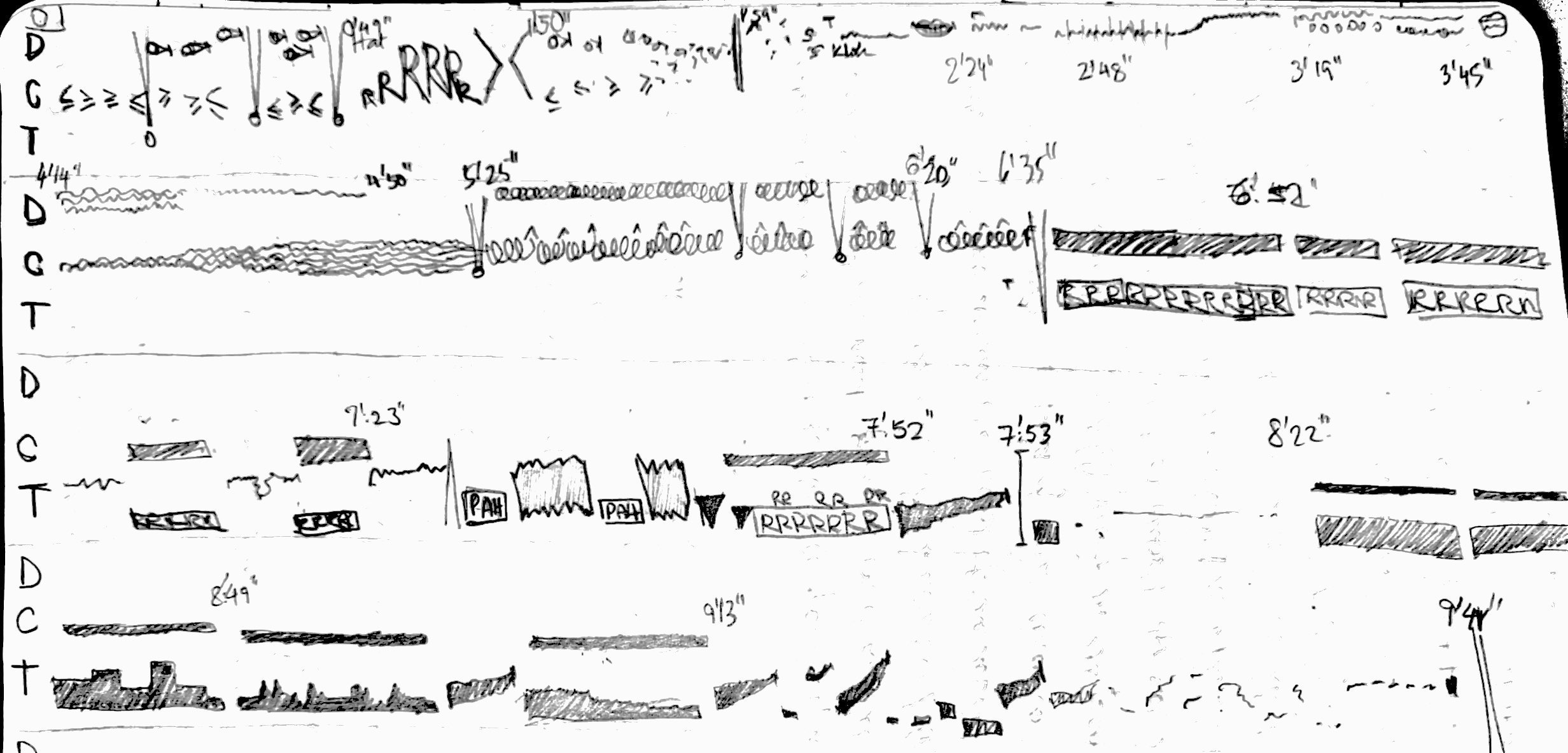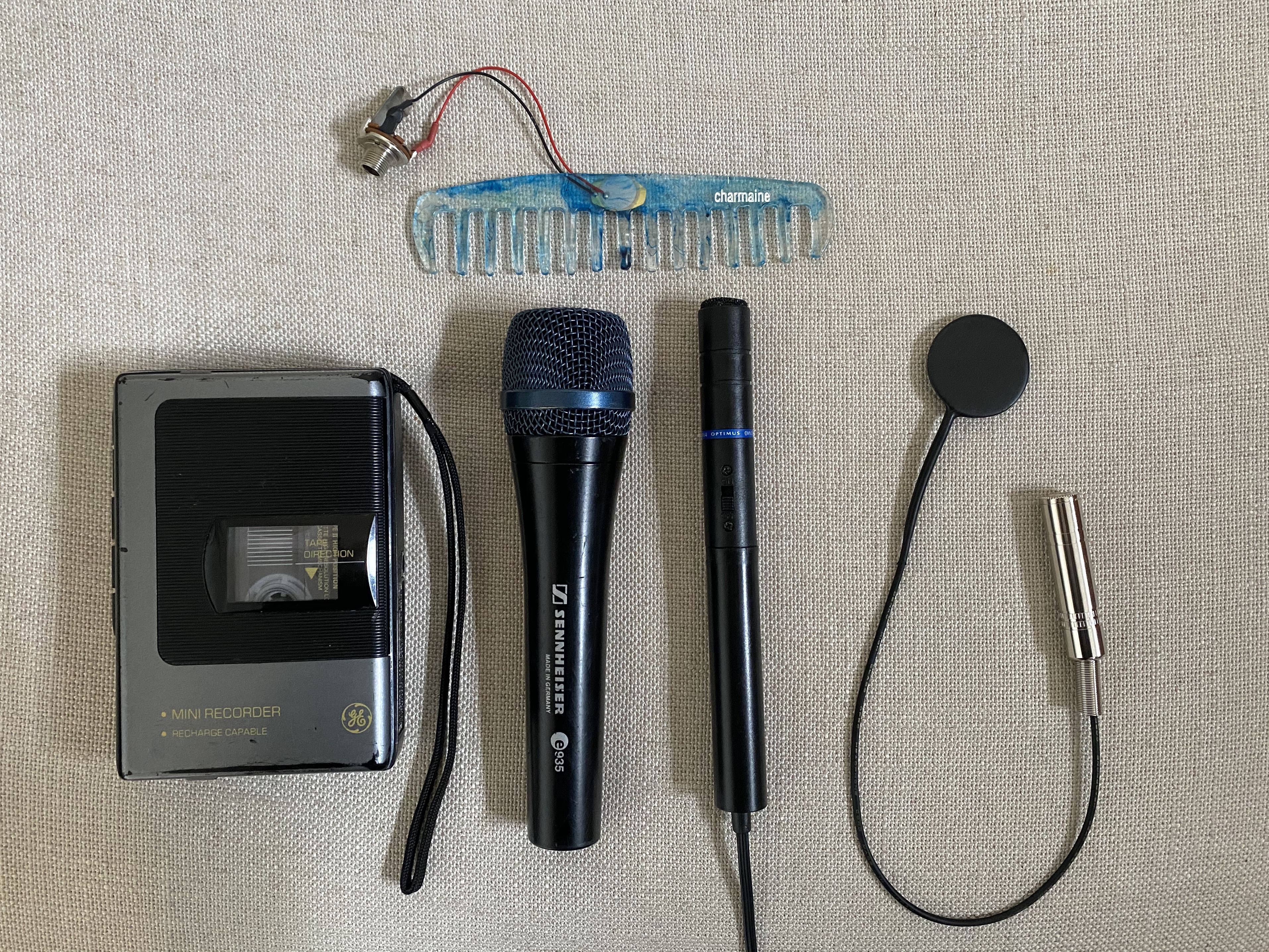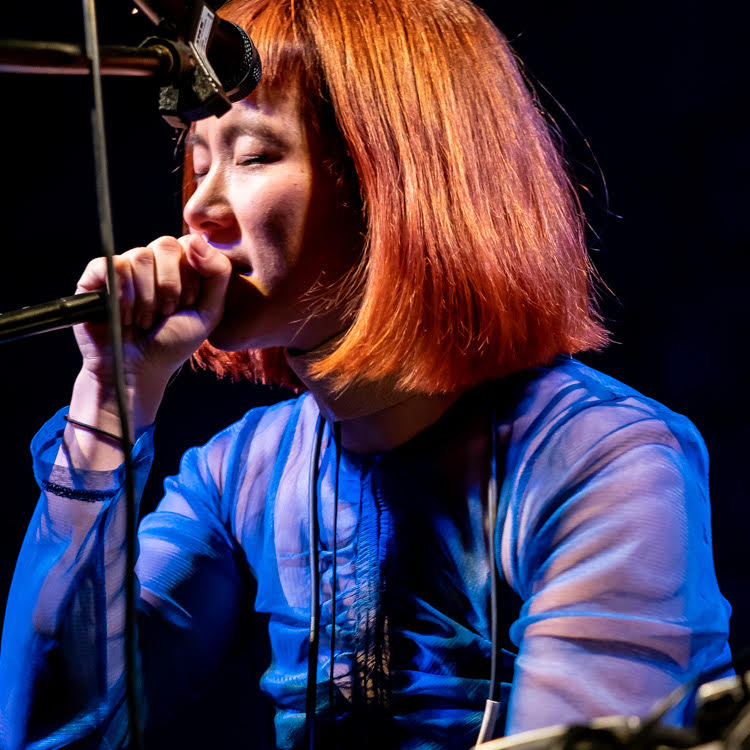n 2016, I completed my masters at the New England Conservatory, where I had arrived two years earlier dreaming of becoming a modern jazz vocalist. This dream evolved dramatically after I impulsively joined Joe Morris’ Free Music Ensemble in my first semester and embarked on what would become a dedicated, long term project to study and practice improvised music (for more detail on this part of my life and general process, see two in-depth interviews for BOMB Magazine and Resonant Bodies Festival). Since then, I have been actively performing in New York and developing a personal language built on the traditions of noise, ASMR, drone, ambient, experimental electronic, and free and new music. Living in New York has given me access to a broad range of art-making, and I am constantly striving to listen openly and dig deeper into the ideas that challenge me or stir curiosity. Through improvisation, I have been able to make meaningful connections with people from a wide variety of approaches and life experiences. I strongly believe the practice is vital to developing empathy and navigating a world of constant social change.
While collaboration has been critical to my process, I decided to highlight my solo work in this analysis, as I feel it best demonstrates the evolution of my concepts in practice. As a vocalist, I tried early on to subvert feelings of self consciousness during performance so that I could tap into a wider range of sonic possibilities, beyond the emotive or associative levels. And while I cringe looking back on earlier footage, I take heart knowing that everything felt utterly real to me in the moment, and that I was fully committed, in the moment, to creating an intimate environment for both myself and the audience. Documentation is a double-edged sword in that it is both essential to growth, but also in that it can reduce the complexity of a lived experience. It is exciting to look back on these past four years and observe the development of my aesthetic priorities - chiefly, contrast, rhythm, technology, physicality, and technique. As I see it, creative identity is an ongoing coalescence of learned concepts, stylistic choices, and life experiences — all distilled into the truest expression of who I am as a person and an artist.
This review process has made me grateful for the people who listened and heard potential in my earliest and rawest performances. At the time, a small number of students at NEC were engaging seriously with improvised music, and I felt quite isolated. Despite this, I was extremely lucky to have had a handful of people believe in me — Joe Morris, Maeve Feinberg, Jeremy Corren, Conrad Tao, and Zach Rowden, whose voices helped me build confidence in the performance and articulation of my music, to the extent that an opportunity was offered to me, then another, and then another after that. Saying ‘yes’ to as many of those invitations as possible was just as important, but the small seeds of encouragement have had a significantly positive impact on my ability to grow and inspire me to proactively support the artists and communities I believe in.
JANUARY 30, 2016. SHAPESHIFTER LAB, BROOKLYN.
This was my very first solo improvised set. And interestingly, my longest live set to date. As much as I want to tear it off the internet, this is a special piece of documentation for me, because it exposes many of my natural impulses in their most raw form. Thanks to Maeve, I was listening to a lot of Autechre, John Hopkins, Burial, and other experimental electronic music at the time. I was attracted to both the timbre of the digital sounds and their propensity for rhythmic groove and pulse. I had so many ideas, which tended to burst out all at once during performance, but no substantial grasp of technique or vocabulary to translate those impulses in a controlled or clean way. At this point I was still riding the line between my familiar experience performing songs and following a deeper urge to make sounds that were totally separate from what I had known about singing prior. My approach was stream-of-consciousness, which lent itself to an elementary and through-composed form (reflected also by the set length). This was my early process — starting as a raw mound of ideas and energy, then shaping and organizing over time into larger chunks informed by formal strategies, deployed through technique. For example, I didn’t yet have the technical acuity to conceive of longer rhythmic durations beyond my breath, such as drone, or even its opposite, silence. I have since developed techniques to create the illusion of length within the limitations of breath. This was also the first time I had performed live using a large diaphragm condenser microphone. Looking back, this process has taken the shape of an hour-glass — absorbing mass amounts of information, shaving away until there is a clear and defined approach, before running wild and expanding back out again. This is how I understand real creative freedom, which must belong to a self-determined and defined framework in order to truly be free.
The performance left a deep emotional impression on me. It was the first time I had a taste of what it felt like to have complete focus and control over the frequency in the air. I was able to play with silence and space in a way that felt deeply personal and intimate. This feeling of high connectivity was so unique and powerful that I felt chemically changed by it. It solidified my belief in spontaneous art-making and made me a champion of live performance. There were about fifteen people in the audience, and one of the attendees told me that the set elicited memories of her own traumatic experiences. After that experience, I began to move away from making explicit emotional associations in favor of abstract music-making (with the understanding that associations are free to be made for whomever is listening).
I did not rehearse the set ahead of time — much of my growth as an improviser has been achieved in a live and public setting. It is the primary method in which I can commit with integrity to the present moment, as well as maintain a high degree of risk-taking and discovery (the most fun and stressful part). This approach of leaving significant room for spontaneous creation shares many similarities with traditions of jazz. I am constantly meditating on this part of the practice, especially as I have started to play more high-profile shows where I feel the psychological pressure to deliver a neatly packaged performance. Nate Wooley once recommended Frank Auerbach to me, a painter who intensely contemplates an object, person, or scene, gathering as much intimate knowledge of it/them as he can, before performing a violent release of the material into a personally “truthful” representation. It helps me stay focused to think that improvisers share a similar approach: gather language, take it apart, know it intimately, and then release it in its most honest form in concert. The focus of preparation for me then is the maintenance and expansion of technique, along with whatever ad hoc approach the performance calls for in a given moment. It is ultimately a balance of preparation and performance, but I feel that live shows are too often viewed as the shiny product of rehearsal, rather than a critical part of the practice itself.
FEBRUARY 5, 2017. UNNAMEABLE BOOKS, BROOKLYN.
This performance was just over a year later, and about six months after I had moved to New York. I knew exactly one person living in New York when I moved, and at this point I knew around six, all of whom were sitting in the audience. I’m grateful that these people are now my good friends and peers in music who I have grown up with since.
This was the first solo performance I did using the handheld dynamic microphone. This set was the marker of a much longer arc of vocabulary and technological development that continues today. At the time, I had just purchased a portable PA system (that I’m using in the video), which enabled my ability to practice at home. I was living in a tiny Chinatown apartment and sharing a fake wall disguised as a closet with my roommate. Amplified practice was challenging but I was able to experiment with close-mic techniques and sounds I gravitated towards. My technique was still messy at this stage — I realized later on that holding my hand over the head of the mic was muffling the detail of the vocal technique that I would later on refine. Dynamics were largely one-dimensional at this point and secondary to the stream-of-consciousness flow that I was adopting at the time. I remember someone comparing this set to “exorcism meets beat-box.” I was plugged directly into the built-in mixer of the PA — EQ was a nascent concept for me back then, but I was learning that certain aspects of the sounds I liked could be accentuated by increasing the highs, decreasing the mid range, and increasing the low end.
One of the most immediate things I notice about this footage is my physicality. I have tried to let my body naturally guide the musical process, which is helpful for tackling mental boundaries of self consciousness that creep in from the exposure of an unaccompanied voice. Around this time I started developing certain physical habits that would help me find flow and something to respond to in solo improvisation. Most of the time these habits were not conducive to “good vocal technique” — for example, I was contorting my body in ways that were suppressing my airflow (leaning all the way down while seated for example), as they were extremely helpful in breaking down psychological barriers. I like wearing tight pants when I perform — the restriction gives me tension to push against, and grounds my mindset in a focused athleticism that I think is necessary for my music.
APRIL 7, 2018. ENDE TYMES IX, BROOKLYN.
My solo sets have almost halved in length each year! I’ve become more concise as my language has become more focused. I had almost forgotten about this little shoutout in the first second of the performance.
Bob Bellerue, longtime organizer, artist, and sound director at ISSUE Project Room, learned of my work through a frequent collaborator, Zach Rowden. He asked us to perform as a duo for the Ende Tymes Festival, a well-known international noise festival that Bob has organized since 2009. Zach unfortunately had booked a tour during that weekend, so Bob asked me if I wanted to perform a solo set. The theme of that year’s festival was entirely new acts and people who had never been a part of the festival.
This was a very important performance for me, perhaps the most important I have had to this date. It marked the beginning of my journey into noise music, microphones, EQ, polyphony, and a community of people who are a significant part of my social and creative interactions today. I produced my first solo record and cassette tape to be sold at the show. I was also going through some major personal changes in my life, and this performance was potent with the sense of diving headfirst into a chapter in which I had no idea where I would land.
Coming out of the free music world, I was used to a listening environment where the listeners were seated on chairs, silent, and focused. The environment of a noise show felt more like a rock concert to me — people were smoking outside, sometimes during all of the sets (this part of the culture still confuses me), and the audience inside was standing, holding beers, and chatting like one would at a bar. There was focus when the performances began, but as you can hear in the audio, there was a fair amount of chatter in the back. I hadn’t anticipated an environment where my silences were padded by casual talk, shifting bodies, and my space surrounded by older men standing very close to me with their arms crossed, seemingly emotionless. I found this experience intimidating, and my performance energy was more combative than I preferred. It’s amusing to me looking back on this now, given that most of the people in the audience are some of the friendliest people I know.
I had been alluding to a noise-based vocabulary using the dynamic handheld microphone for some time, and I saw this festival as an opportunity to go deeper using microphones of different qualities and fidelities. I had recently acquired a contact microphone made by a friend from a composition program I had participated in the year prior, and had been experimenting with placing it on my throat to see if I could bring out interesting tones. The contact mic inspired me to explore interactions with gargling and water through its placement near the thyroid. I found self-adhesive medical tape was the easiest way for me to hold the microphone in place while also giving room for movement (and sweat!). In addition, I found a handheld microphone attached to a RadioShack tape recorder from the 90s (lovingly named “The Shotgun”) that had a crunchy distortion if I brought the gain all the way up on my mixer (which also became a permanent and crucial addition to my setup). This setup was my first foray into a new kind of polyphony, opening possibilities of combinations that I started to log in my journal and still continue today.
While these additions were exciting, I was essentially adding two new instruments to my setup with a short period of preparation (around two weeks). The microphones threw an unexpected wrench into my improvised flow — I had never had to consider transitions to microphones mid-set, as everything prior had been seamlessly on one microphone. I was experiencing the added anxiety of performing in front of a new community of strangers, and decided to give Joe Morris a call. I still refer to my handwritten scribbles from our hour-long conversation. I was worried about the expectations of this festival when I wasn’t really considering myself a “noise musician” at that point. He encouraged me to turn the expectation back on its head and see the invitation as a question: what is this festival about? My performance was my answer. I was also worried about the new technological components and whether they were distractions from actual progress. Joe told me that sometimes technological explorations exist only to inspire and expand our vocabulary without them. I wouldn’t come to appreciate this advice until much later. Joe also said it could be helpful to group my vocabulary by characteristics rather than techniques. I loved the idea of framing vocabulary in terms of its emotional subtext and felt this was applicable to my practice.
I remember absolutely hating my performance as soon as it was over — I felt the adrenaline had undermined my sense of composure and control. But I knew it needed to happen in this exact context to push into new levels of thinking and imagination.
MARCH 9, 2019. ISSUE PROJECT ROOM, BROOKLYN.
I was very fortunate to be selected as an Artist-in-Residence at ISSUE Project Room in 2019. At this point, I had been using the contact/shotgun/dynamic mic setup for eleven months and was finally feeling a sense of comfort. I made a few additional adjustments to minimize transition time as much as possible, including adding a volume foot pedal to my contact microphone so I could free my hands from muting and unmuting the channel. I had also begun a deeper journey into noise music — discovering classic recordings from The Rita, Richard Ramirez, The New Blockaders, Masonna, Andrea Pensado, M.S.B.R., Kazehito Seki, and SICKNESS. I felt an immediate visceral response to the explosive sound quality, physical execution in performance, and the controlled chaos on the brink of collapse. I was able to get closer to this sound world through the use of the distorted shotgun microphone. Because the gain was so high for this channel on my mixer, I was experiencing issues with unwanted feedback when using the shotgun live. A friend who is a sound engineer recommended a 15-band graphic equalizer so that I could attenuate the specific frequencies that were ringing from the microphone's response to the speaker and performance space. This helped shape my sound and I became much more strict about soundchecks before every performance, no matter how casual. Since the music is improvised, I learned that it is crucial for me to gain comfortability ahead of time with the sound system and space, as it heavily influences the vocabulary used in the performance.
For my inaugural residency performance, I decided to use the opportunity to go deeper into the setup and vocabulary I had been working on for those eleven months, and introduce a new component exploring feedback more concretely. A close friend and collaborator id m theft able had mailed me an old portable tape recorder with a built in microphone, which I discovered had a whimsical and unusual feedback response. I decided to add two of these tape recorders to my setup (now five microphones) with contrasting EQ settings. In this performance [12:51 - 14:35], I discovered the sensation of creating multiple streams of activity with independent timeframes. Coming from an instrument in which every sound is the product of an immediate decision, this idea of creating independent activity through feedback while simultaneously producing other sounds with my microphones was particularly revelatory and revealing of new possibilities for polyphony and counterpoint.
APRIL 17, 2020. EXPERIMENTAL SOUND STUDIO QUARANTINE CONCERT, LIVE-STREAM.
I will focus on 11:30 - 19:49 for the purpose of this analysis.
I performed a live stream set for the Experimental Sound Studio Quarantine Concerts series a few days ago, just over a year since my first performance at ISSUE Project Room. Towards the end of 2019, I had been collaborating with Chris Goudreau, an influential noise artist who introduced me to the modular sound and systems. I had been avoiding live processing for some time, determined to establish a foundation of technique and style without a heavy reliance on technology. Chris approached me with some ideas about a system to bridge our sound worlds, and helped me design a small modular unit to trial a few digital processing effects. I was surprised to find that effects like granular sampling, pitch modulation, amplitude modulation, and reverb could accentuate and highlight certain features of my vocabulary and not overtake my vocal sound. The effects encourage more use of pitch material, and I am enjoying bringing my attention back to concepts like harmony and melody that I had abandoned for a little while. The system opens new components for interaction in solo improvisation, similar to my relationship with the independent streams of feedback, and I am excited to explore these possibilities further.
APRIL 12, 2020. OPEN IMPROVISATION, LIVE STREAM.
This recent performance was the first time I had exclusively used a large diaphragm condenser microphone since the Shapeshifter Lab performance four years earlier. While unplanned, it is fitting to close my analysis with the return to the setup I used for my first solo performance. Unlike the 2016 set, I can hear the influence of the past few years’ worth of exploration with microphones, feedback, and digital processing through wider dynamic, spatial, and durational range, and maturity of phrasing. Physically, I exert significantly less energy than when I started, largely for economical reasons, and a reflection of the techniques I’ve cultivated that require a certain level of concentration and physical stillness in order to execute. While I can certainly pinpoint areas for improvement, it is exciting to see growth in technique and increasing complexity of ideas.
— — —
I want to mention that while it has not been the focus of this analysis, collaboration has been a crucial part of the expansion and development of my vocabulary. It is a priority of mine to maintain a language that is both strong in its identity and malleable enough to interact with a broad range of styles, aesthetics, and approaches. By applying Joe’s methodology of interaction and my own understanding of improvisation, I am able to respond to a variety of musical environments through active listening. Collaboration has given me a wider context to express my personal language, and a space to exchange ideas that I would not have developed on my own. I am very grateful to find collaborators I can work with over long periods of time, growing independently while deepening a mutual foundation of ideas, trust, and exchange.
I often feel that my practice is both expanding in new directions and contracting to the smallest degree. As I continue to grow in my setup and vocabulary, I also have been returning to the bare minimum, almost as a way of testing that my body and voice is primarily the maker of the music. Ideally, this practice could run in parallel to the exploration of new ideas and technology. No matter the mechanical or aesthetic changes, I am learning that I will always find a way to return to my voice in its most basic form.






